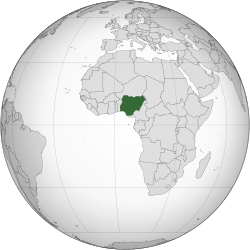မိူင်းၼၢႆႇၵျီးရီးယႃး
Appearance
(လုၵ်ႉတီး ၼၢႆႇၵျီးရီးယႃး ၼႆႈသေ ၶိုၼ်းပိၼ်ႇဝၢႆႇမႃး)
| မိူင်းၸွမ်ပွင်ၸိုင်ႈ ၾႅတ်ႇတရႄႇ ၼၢႆႇၵျီးရီးယႃး | |||||
|---|---|---|---|---|---|
| |||||
|
ၶေႃႈၶၼ်ပၢၵ်ႇ: "Unity and Faith, Peace and Progress" | |||||
 | |||||
| ဝဵင်းငဝ်ႈၸိုင်ႈ |
Abuja 9°4′N 7°29′E / 9.067°N 7.483°E | ||||
| ၽႃႇသႃႇၵႂၢမ်း ၸႂ်ႉၼႂ်းလုမ်း | ဢိင်းၵလဵတ်ႈ | ||||
| မဵဝ်းမိူင်း | မိူင်းၸွမ်ပွင်ၸိုင်ႈ ၾႅတ်ႇတရႄႇ | ||||
| လူင်ပွင်ၸိုင်ႈ | |||||
• ၸွမ်ပွင်ၸိုင်ႈ | Muhammadu Buhari | ||||
• ၵႅမ်ၸွမ်ပွင်ၸိုင်ႈ | Yemi Osinbajo | ||||
| တႄႇတင်ႈ | |||||
• ၼၢႆႇၵျီးရီးယႃး ႁွင်ႇလႄႈၸၢၼ်း ႁူမ်ႈၵၼ် | 1914 | ||||
• လွတ်ႈလႅဝ်းသဝ်းၶေႃ (တီႈ ယူႇၶေႇ) | 1960၊ ဢွၵ်ႇထူဝ်ႇပႃႇ 1 | ||||
• ပူၵ်းတင်ႈ မိူင်းၸွမ်ပွင်ၸိုင်ႈ | 1963၊ ဢွၵ်ႇထူဝ်ႇပႃႇ 1 | ||||
| ႁူဝ်ၼပ်ႉၵူၼ်း | |||||
• 2020 လၢမ်း | 204,630,269[1] (ၸၼ်ႉ - 7th) | ||||
• 2006 သဵၼ်ႈမၢႆႁူဝ်ႁိူၼ်း | 140,431,691 | ||||
• လွင်ႈသတ်ႉႁူဝ်ၼပ်ႉၵူၼ်း | (ၸၼ်ႉ- 42nd) | ||||
| GDP (PPP) | လၢမ်း 2020 | ||||
• ႁူမ်ႈ | $1.275 trillion[2] (ၸၼ်ႉ- 23rd) | ||||
• Per capita | $6,232 (ၸၼ်ႉ - 129th) | ||||
| GDP (nominal) | လၢမ်း2020 | ||||
• ႁူမ်ႈ | $504.57 billion[2] (ၸၼ်ႉ- 27th) | ||||
• Per capita | $2,465 (ၸၼ်ႉ - 137th) | ||||
| Gini (2020) |
ၵၢင် | ||||
| HDI (2018) |
0.534[4] တႅမ်ႇ · 158th | ||||
| ငိုၼ်းတွင်း | Naira (₦) (NGN) | ||||
| ၶၢဝ်းယၢမ်းၼႃႈလိၼ် | WAT (UTC+01:00) | ||||
| ပိူင်သၢႆလူတ်ႉ | မိုဝ်းၶႂႃ | ||||
| ၶူတ်ႉတႄႇလီႇၾူင်း | +234 | ||||
| Internet TLD | .ng | ||||
ၽိုၼ်ဢိင်
[မႄးထတ်း | မႄးထတ်းငဝ်ႈငႃႇ]- ↑ "UN Projection", World Population Prospects 2017
- ↑ 2.0 2.1 World Economic Outlook Database, October 2018 – Nigeria. International Monetary Fund. Retrieved on 20 October 2018။
- ↑ Poverty and Inequality Index.
- ↑ Human Development Report 2019 (PDF) (in en). United Nations Development Programme (10 December 2019). Archived from the original on 30 April 2020။ Retrieved on 10 December 2019။


